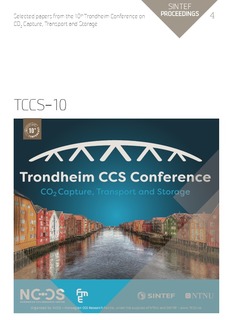| dc.contributor.author | Yoro, Kelvin O. | |
| dc.contributor.author | Chiwaye, Natsayi | |
| dc.contributor.author | Isafiade, Adeniyi J. | |
| dc.contributor.author | Daramola, Michael O. | |
| dc.date.accessioned | 2020-01-27T13:33:59Z | |
| dc.date.available | 2020-01-27T13:33:59Z | |
| dc.date.issued | 2019 | |
| dc.identifier.isbn | 978-82-536-1646-9 | |
| dc.identifier.issn | 2387-4295 | |
| dc.identifier.uri | http://hdl.handle.net/11250/2638104 | |
| dc.description.abstract | Heat and mass exchange occur concurrently during CO2 capture. Therefore, the application of a combined heat and mass exchanger network (CHAMEN) could be a very good option to reduce energy and material consumption simultaneously during CO2 capture. In this study, a systematic technique for the synthesis of combined heat and mass exchanger networks (CHAMENs) was introduced to concurrently minimize the use of external utilities and mass separating agents (MSA) during adsorptive CO2 capture. The method proposed in this study is based on an innovative approach that integrates a mathematical programming technique for the heat exchanger networks (HENs) synthesis and a sequentially-based composition interval technique for mass exchanger networks (MENs) synthesis with regeneration. A combined optimization approach was used to minimize the total annualized cost of the synthesized CHAMEN. An example was solved to test the efficacy of the proposed method. The cost of mass separating agents, as well as hot and cold utilities which form the total annualized costs (TAC) for the combined heat and mass exchangers, was minimized. The total annualized cost (TAC) of the synthesized CHAMEN obtained in this study (TAC=$199800/yr) showed significant improvement over the TAC reported in the literature using other synthesis techniques. Results obtained in this study confirmed that the integration of a combined heat and mass exchanger with regeneration network is an effective way to minimize heat and mass during adsorptive CO2 capture. The combined heat and mass exchanger networks adequately satisfied the heat and mass balance of the process with a lower total annualized cost | |
| dc.language.iso | eng | |
| dc.publisher | SINTEF Academic Press | |
| dc.relation.ispartof | Proceedings of the 10th Trondheim Conference on CO2 Capture, Transport and Storage ; TCCS-10, 2019 | |
| dc.relation.ispartofseries | SINTEF Proceedings;4 | |
| dc.rights | CC BY NC ND | |
| dc.rights.uri | http://creativecommons.org/licenses/by-nc-nd/4.0/ | |
| dc.subject | Adsorption | |
| dc.subject | CO2 capture | |
| dc.subject | Combined heat and mass exchanger network | |
| dc.subject | Energy minimization | |
| dc.subject | Mass separating agent | |
| dc.subject | Process optimization | |
| dc.title | Energy and Material Minimization During CO2 Capture Using a Combined Heat and Mass Integration Technique | |
| dc.type | Chapter | |
| dc.type | Conference object | |
| dc.type | Peer reviewed | |
| dc.description.version | publishedVersion | |
| dc.rights.holder | © The authors. Published by SINTEF Academic Press 2019 This is an open access publication under the CC BY-NC-ND license | |
| dc.subject.nsi | VDP::Teknologi: 500 | |

